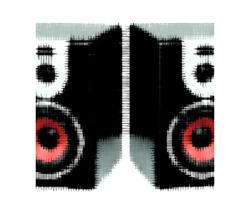“I recently purchased a really good (expensive) set of studio monitors for my studio, but I still find that my mixes sound drastically different as I listen to them on other systems. What am I missing?”
While the studio monitors themselves are probably the single greatest cause of this problem, there are a number of other related factors that can have a significant impact. We’ll address three of them here.
1) Acoustic Treatment. It’s safe to assume that the decisions you make while tracking, editing and mixing are based on what you hear. If you’re mixing in a room that has detrimental reflections like standing waves, flutter echoes and low frequency room modes (and nearly EVERY rectangular room does!), then it’s nearly impossible to hear the mix without being influenced by these common sound issues.
In other words, you might over or under compensate low frequencies, or the placement of lead vocals in a mix – and that’s just the start! The good news is that by implementing the proper acoustical treatments, you can make even the worst sounding room good enough to be useful. Controlling reflections yields truer sound and allows the “real” sound of an instrument or voice to come through.
Beyond the physical construction of the room, which at this point we’ll assume you don’t have a lot of control over, the two methods of controlling sound are sound absorption and sound diffusion (we shouldn’t forget about bass traps, but those technically fall into the category of absorption). Companies like Auralex and RPG have world-class acoustic treatment solutions that are both affordable and amazingly effective.
2) Decouple Your Monitors. Everything in your studio that vibrates contributes artifacts to the sound of your mix. Typically our monitors are acoustically coupled to a shelf, a rack, stand, or the meter bridge of our mixing boards. Doing this automatically degrades the accuracy of what you’re hearing. And once your monitors cause whatever they’re resting on to vibrate, everything else that’s in physical contact with your monitors also starts to vibrate, which just adds to the problem. Auralex makes a nifty and inexpensive product to address this called the MoPAD.
MoPADs provide sonic isolation between your monitors and whatever your monitors are resting on, instantly improving the accuracy of your entire monitoring system. Using the MoPADs allow you to hear the sound of the monitors more directly, without the interference caused by the way they interact with their resting surface.
3) Listening Position. At the listening position, constructive and destructive interference between your monitor’s direct sound and reflections from adjacent boundaries causes severe peaks and dips in the frequency response.
In addition, acoustic resonances or room modes cause substantial acoustical gain or attenuation at frequencies determined by the room’s dimensions. While it is important to provide uniform modal frequency distribution by acoustically treating the room, the degree of acoustic gain at each frequency depends solely on the location of the listener and loudspeakers with respect to the room’s sound pressure distribution at that frequency.
In other words, the placement of your monitors and the listening position has a tremendous effect on your ability to hear your mix accurately. Room Optimizer by RPG is a program that utilizes modern geometrical image model prediction techniques along with powerful multi-dimensional optimization to achieve the smoothest and flattest bass response in a rectangular room – it tells you where to place your monitors relative to the listening position.
This result is accomplished quickly, effectively, and automatically by properly positioning the listener and loudspeakers.
You may find that a different layout of your studio will significantly improve the sound at the listening position, and thus your overall results. With the wide variety of racks, desks, and stands available today it’s easier than ever to reconfigure your studio into not only a better sounding environment, but one that ergonomically allows you to be more productive.
Most people who put studios in their homes or other non-conventional spaces go through at least two or three iterations of their setup before arriving at something they can be happy with for any length of time.




















